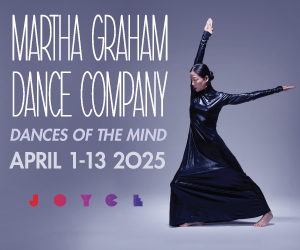IMPRESSIONS: Akram Khan's "Gigenis: The Generation of the Earth" at The Joyce Theater

Directed by: Akram Khan
Musicians and Vocalists: BC Manjunath, Kalamandalam Rajeev, Hariraam Lam, Nina Harris, Sohini Alam, Chitra Poornima Sathish, Rohith Jayaraman
Lighting Design: Zeynep Kepekli
Music Orchestration: Jyotsna Prakash
Sound Designer: Dave Price
Sound Engineer: Mark Webber
Costume Designer: Peggy Housset
Producer: Vony Sarfati
Dances: Akram Khan, Sirikalyani Adkoli, Renjith Babu, Mavin Khoo, Mythili Prakash, Vijna Vasudevan, Kapila Venu
Dates: February 12 - 16, 2025
A woman emerges out of the darkness, slashing her arms with brutal force as if fighting an unseen advisory. Sounds of crashing thunder accompany her ferocity. With a terrifying grimace she reaches down and pulls invisible entrails from her slain foe and holds them to her face. This gruesome scene is the opening to Akram Khan’s Gigenis: The Generation of the Earth. The work is inspired by Mahabharata, the Indian epic tale in which Queen Gandhari, portrayed by Kapila Venu, loses her sons in a war brought about by their own ambition.
An impeccable storyteller who both directs and performs in his adaptation, Khan tells this tale of seductive power and cyclical violence through the lens of a mother’s grief. Known primarily for his work in contemporary forms, Gigenis also serves as Khan’s return to his roots in Indian classical dance. Trained in Kathak, he gathers expert dancers and musicians in Bharatanatyam and Odissi for this production, directing an ensemble of artists from the classical tradition for the first time in his career.

Following its brutal beginning, the narrative turns briefly to happier times. The wedding blessing of a man and woman evolve into solos, trios, and ensemble dancing that portray young love and maturation, then discord and divide. Scenes from Gandhari’s past flow by with seamless transitions as Venu, an intensely powerful performer, mirrors each dancer, echoing their movements alongside them, ghost-like, as if remembering. Her intensity — bulging eyes, glowering lips, carving arms that push the air as if it weighs a ton — holds the entire audience in a silent concentration I have rarely witnessed or experienced at a dance performance. Venu is a master of Kutiyattam, a 2,000 year old theater tradition that usually involves elaborate makeup and costumes; she works without those tools here, yet loses none of her power. While not every spectator can relate to the pain of losing a child or husband, themes of violence, devastation, suffering, and death are universal. Within the Joyce Theater’s intimate space, even those in the furthest seats are drawn into Gigenis’ emotional landscape.

Odissi dancer Sirikalyani Adkoli embodies Gandhari’s youth and flirty innocence with mesmerizing wave-like arm and hand gestures. Renjith Babu, as her husband, the king, joins Vijna Vasudevan who portrays another version of Gandhari, in a delicate, coiling duet in which their hands entwine to represent a bird in flight. Khan and Mavin Khoo cleave to Mythili Prakash, the most aged version of the Queen, in a foreboding scene of royal succession as they pass around an invisible crown. Small, precise movements of the solar plexus remind me of the impetus in Isadora Duncan’s technique, illustrating deep emotion. As the dancers expand, contract and undulate their upper chests, we feel their pride, rage, joy and grief.

Zeynep Kepekli's minimal lighting creates an ominous mood and reminds us of the pure, timeless power of movement, at the same time highlighting the intricacies of the hand gestures that are integral to Indian classical dance. In one solo, Prakash holds the invisible crown in a shaft of light, her fingers nimbly curling and unfurling at a pace so rapid they begin to look like licking flames, rising out of darkness. Khan mimics this speed in a sinister solo, grabbing the crown and spinning across the stage, consumed by sibling rivalry and avarice.

After their father the king dies, Khan and Khoo fight over the crown until one kills the other, the action overlayed by a soft female voice narration. “In another time, I was a daughter, then a wife, then a mother.” The more these phrases are repeated, the more they resonate, reminding us of the many roles we play in our own lives and the bittersweet passing of time. “Not just in another time, but several times.” The tragedy unfolding on stage is magnified by the score and haunting vocalizations of the onstage musicians. Melodies float and overlap and the drummers drive a ceaseless momentum. The sound is dramatic, meditative, roaring and sensitive all at once. Sounds of war- loud booms and crashes- interrupt calmer tones as the score repeatedly rises to a crescendo, arrests in moments of silence, and repeats, mimicking the cyclic nature of life itself, full of pain and joy. Gigenis leaves us considering the harrowing aspects of existence as it closes. “This is not war,” the narrator says. “This is the end of the world. And again, I am alone.”













